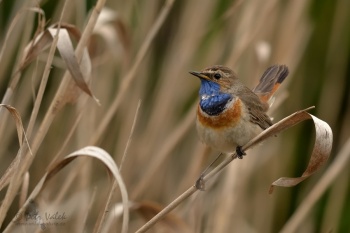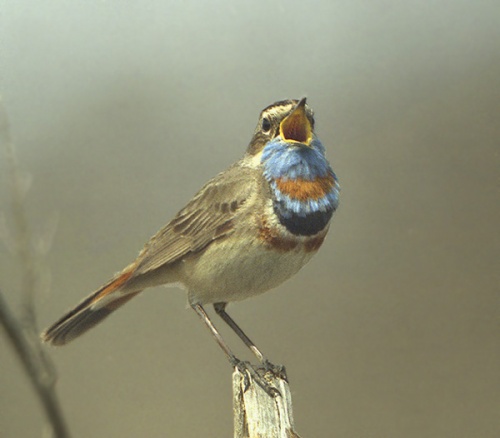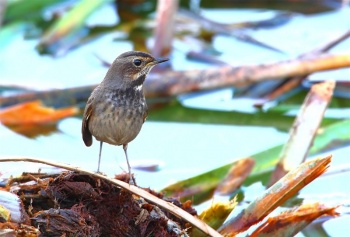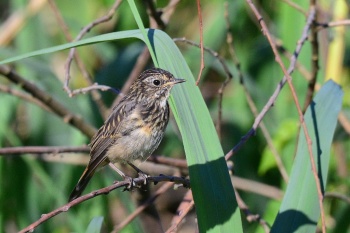(taxon, refs) |
|||
| (20 intermediate revisions by 4 users not shown) | |||
| Line 1: | Line 1: | ||
| + | [[Image:Bluethroat.jpg|thumb|500px|right|Photo © by {{user|pavlik|pavlik}}<br /> Saratov, [[Russia]], April 2004]] | ||
;[[:Category:Luscinia|Luscinia]] svecica | ;[[:Category:Luscinia|Luscinia]] svecica | ||
| − | |||
==Identification== | ==Identification== | ||
| − | + | [[Image:Bluethroat 4464.jpg|thumb|350px|right|Female<br />Photo © by the late '''[http://www.birdforum.net/gallery/showgallery.php?cat=500&ppuser=35827 Jim Wood]'''<br />Quito Do Lago, [[Portugal]], 2009 ]] | |
| + | 13–15 cm (5-6 in) | ||
| + | *Dark brown plumage | ||
| + | *White eyestripe | ||
| + | *White [[Topography#Heads|moustachial]] stripe (reminiscent of a small [[Redwing]] | ||
| + | *Red patches on tail sides (all ages)<br /> | ||
| + | '''Male''': blue throat, which may have red or white spots depending on the subspecies<br /> | ||
| + | '''Female''': throat mainly white with a dark band over the breast | ||
==Distribution== | ==Distribution== | ||
| + | [[Image:bluethroat_alok_2.JPG|thumb|350px|right|Subspecies ''L. s. abbotti'' : male in breeding plumage<br />Photo © by {{user|aloktewari|Alok Tewari}}<br />Basai Wetlands, Gurgaon, Haryana, [[India]], March-2018]] | ||
Main breeding range is in the north and east of the Region, breeds through most of [[Norway]], upland [[Sweden]] and north [[Finland]] and from [[Poland]] and the [[Baltic States]] east to the [[Urals]], breeding south to northern [[Ukraine]]. Also breeds in very scattered pockets across [[Europe]] in [[Spain]] and west and central [[France]] east to [[Hungary]] with an isolated population in the [[Caucasus]] and north-east [[Turkey]]. Has bred in [[Britain]], [[Switzerland]], [[Italy]] and [[Romania]]. | Main breeding range is in the north and east of the Region, breeds through most of [[Norway]], upland [[Sweden]] and north [[Finland]] and from [[Poland]] and the [[Baltic States]] east to the [[Urals]], breeding south to northern [[Ukraine]]. Also breeds in very scattered pockets across [[Europe]] in [[Spain]] and west and central [[France]] east to [[Hungary]] with an isolated population in the [[Caucasus]] and north-east [[Turkey]]. Has bred in [[Britain]], [[Switzerland]], [[Italy]] and [[Romania]]. | ||
| Line 10: | Line 18: | ||
Vagrants recorded [[Iceland]] and [[Faroes]], [[Ireland]] and [[Greece]]. | Vagrants recorded [[Iceland]] and [[Faroes]], [[Ireland]] and [[Greece]]. | ||
==Taxonomy== | ==Taxonomy== | ||
| − | ===Subspecies=== | + | ====Subspecies==== |
| − | A number of races occur in the Western Palearctic some of which are separable in the field, differing in throat colour of breeding male. The nominate ''svecica'' | + | [[Image:Aves 0709.JPG|thumb|350px|right|White-spotted Bluethroat, subspecies ''cyanecula''<br />Photo © by {{user|PetrValek|PetrValek}}<br />North Bohemia, [[Czech Republic]], May 2017]] |
| + | [[Image:STH 2051.JPG|thumb|350px|right|Juvenile<br />Photo © by {{user|volker+sthamer|volker sthamer}}<br />Waghäusel, [[Germany]], June 2017]] | ||
| + | A number of races occur in the [[Western Palearctic]] some of which are separable in the field, differing in throat colour of breeding male. The nominate ''svecica'' has a blue throat with red central spot and broad black band beneath. Central European ''cyanecula'' has white throat spot (or, rarely, none at all), and darker upperparts and ''namnetum'' is similar but smaller. [[Russia|South Russian]] ''pallidigularis'' has pale chestnut bar or triangle on paler blue throat and narrower black band and Caucasian ''magna'' is similar but larger. | ||
| + | |||
| + | However, there is much individual variation and intergradation between races and isolated pockets of red-spotted birds within range of ''cyanecula.'' | ||
| + | |||
| + | There are 12 subspecies<sup>[[#References|[1]]]</sup> | ||
| + | *''L. s. svecica'': [[Scandinavia]] across [[Siberia]] to western [[Alaska]]; winters North [[Africa]], southern [[Asia]] | ||
| + | *''L. s. namnetum'': Western [[France]] | ||
| + | *''L. s. cyanecula'': Central [[Europe]] and [[Spain]]; winters to North [[Africa]] | ||
| + | *''L. s. azuricollis'': Northern Spain | ||
| + | *''L. s. volgae'': North-eastern [[Ukraine]] to middle Volga River | ||
| + | *''L. s. magna'': Caucasus area, eastern [[Turkey]] and [[Iran]]; winters to [[Sudan]] and [[Ethiopia]] | ||
| + | *''L. s. luristanica'': Armenia to south-western [[Iran]]; winters to [[Iraq]] and the [[Sudan]] | ||
| + | *''L. s. pallidogularis'': South-western [[Siberia]] to [[Turkmenistan]], Altai Mountains and upper Yenisey | ||
| + | *''L. s. saturatior'': Pamir Mountains and Tien Shan Mountains | ||
| + | *''L. s.a abbotti'': Western [[Pakistan]] and north-western [[India]] | ||
| + | *''L. s. przewalskii'': distribution poorly defined (probably is a junior synonym of ''pallidogularis''); breeds [[Siberia]], winters in southern [[China]] (Yunnan) and southeastern [[Asia]] | ||
| + | *''L. s. kobdensis'': Western [[China]] (Xinjiang) | ||
See [http://www.birdforum.net/showthread.php?t=137126 this thread] for a discussion of [[Bluethroat]] subspecies. | See [http://www.birdforum.net/showthread.php?t=137126 this thread] for a discussion of [[Bluethroat]] subspecies. | ||
| − | |||
==Habitat== | ==Habitat== | ||
Breeds on wooded tundra, open birch forest and willow scrub often close to water in thickets beside lakes, rivers and swamps. Out of the breeding season in reedbeds, open grassland and in cultivated areas. | Breeds on wooded tundra, open birch forest and willow scrub often close to water in thickets beside lakes, rivers and swamps. Out of the breeding season in reedbeds, open grassland and in cultivated areas. | ||
==Behaviour== | ==Behaviour== | ||
| − | The Bluethroat is a ground forager and also captures insects in the air. | + | ====Movement==== |
| − | ==Diet== | + | The Bluethroat is a ground forager when it constantly runs-stops-and-flicks; it also captures insects in the air. |
| + | ====Breeding==== | ||
| + | Breeds in overgrown wet bushy areas. | ||
| + | ====Diet==== | ||
The diet includes insects, caterpillars and berries | The diet includes insects, caterpillars and berries | ||
| − | ===Vocalisation=== | + | ====Vocalisation==== |
| − | + | {{ Audio|Luscinia svecica (song).mp3 }} | |
| − | + | ||
| + | ==Gallery== | ||
| + | Click images to see larger version | ||
| + | <gallery> | ||
| + | Image:bluethroat_alok.JPG|Male in Winter, Ssp. ''abbotti'' <br />Photo © by {{user|aloktewari|Alok Tewari}}<br />Gurgaon, [[India]], Jan-2017 | ||
| + | Image:Bluethroat-5095.jpg|First winter male<br />Photo © by {{user|john-henry|john-henry}}<br />Algarve, [[Portugal]], November 2009 | ||
| + | Image:Bluethroat ad in flight - Copie pour bf.jpg|Subspecies ''namnetum'' <br />Photo © by {{user|bru.b|bru.b}}<br />L'aiguillon, Vendée, Pays-de-la-Loire, [[France]] | ||
| + | </gallery> | ||
| + | ==References== | ||
| + | #{{Ref-Clements6thOct22}}#{{Ref-GillDonskerRasmussen22V13.2}}#Birdguides | ||
| + | {{ref}} | ||
==External Links== | ==External Links== | ||
| − | {{GSearch|Luscinia | + | {{GSearch|"Luscinia svecica" {{!}} "Bluethroat"}} |
<br /> | <br /> | ||
| − | {{ | + | {{VSearch|"Bluethroat" {{!}} "Bluethroat"}} |
| − | [[Category:Birds]] [[Category:Luscinia]] [[Category:Bird Songs]][[Category:Videos]] | + | {{GS-checked}} |
| + | <br /> | ||
| + | <br /> | ||
| + | |||
| + | [[Category:Birds]] [[Category:Luscinia]] [[Category:Bird Songs]] [[Category:Videos]] | ||
Latest revision as of 23:59, 4 November 2023
- Luscinia svecica
Identification
13–15 cm (5-6 in)
- Dark brown plumage
- White eyestripe
- White moustachial stripe (reminiscent of a small Redwing
- Red patches on tail sides (all ages)
Male: blue throat, which may have red or white spots depending on the subspecies
Female: throat mainly white with a dark band over the breast
Distribution

Photo © by Alok Tewari
Basai Wetlands, Gurgaon, Haryana, India, March-2018
Main breeding range is in the north and east of the Region, breeds through most of Norway, upland Sweden and north Finland and from Poland and the Baltic States east to the Urals, breeding south to northern Ukraine. Also breeds in very scattered pockets across Europe in Spain and west and central France east to Hungary with an isolated population in the Caucasus and north-east Turkey. Has bred in Britain, Switzerland, Italy and Romania.
A migrant over most of range leaving in August-September to winter around the Mediterranean in small numbers, more commonly in sub-Saharan Africa and the Middle East and returning in March-May. Passage birds occur throughout Europe including Britain where 50-150 occur in most years, mainly on the east coast and Shetland in particular with May and September the peak months.
Vagrants recorded Iceland and Faroes, Ireland and Greece.
Taxonomy
Subspecies

Photo © by PetrValek
North Bohemia, Czech Republic, May 2017
A number of races occur in the Western Palearctic some of which are separable in the field, differing in throat colour of breeding male. The nominate svecica has a blue throat with red central spot and broad black band beneath. Central European cyanecula has white throat spot (or, rarely, none at all), and darker upperparts and namnetum is similar but smaller. South Russian pallidigularis has pale chestnut bar or triangle on paler blue throat and narrower black band and Caucasian magna is similar but larger.
However, there is much individual variation and intergradation between races and isolated pockets of red-spotted birds within range of cyanecula.
There are 12 subspecies[1]
- L. s. svecica: Scandinavia across Siberia to western Alaska; winters North Africa, southern Asia
- L. s. namnetum: Western France
- L. s. cyanecula: Central Europe and Spain; winters to North Africa
- L. s. azuricollis: Northern Spain
- L. s. volgae: North-eastern Ukraine to middle Volga River
- L. s. magna: Caucasus area, eastern Turkey and Iran; winters to Sudan and Ethiopia
- L. s. luristanica: Armenia to south-western Iran; winters to Iraq and the Sudan
- L. s. pallidogularis: South-western Siberia to Turkmenistan, Altai Mountains and upper Yenisey
- L. s. saturatior: Pamir Mountains and Tien Shan Mountains
- L. s.a abbotti: Western Pakistan and north-western India
- L. s. przewalskii: distribution poorly defined (probably is a junior synonym of pallidogularis); breeds Siberia, winters in southern China (Yunnan) and southeastern Asia
- L. s. kobdensis: Western China (Xinjiang)
See this thread for a discussion of Bluethroat subspecies.
Habitat
Breeds on wooded tundra, open birch forest and willow scrub often close to water in thickets beside lakes, rivers and swamps. Out of the breeding season in reedbeds, open grassland and in cultivated areas.
Behaviour
Movement
The Bluethroat is a ground forager when it constantly runs-stops-and-flicks; it also captures insects in the air.
Breeding
Breeds in overgrown wet bushy areas.
Diet
The diet includes insects, caterpillars and berries
Vocalisation
Gallery
Click images to see larger version
Male in Winter, Ssp. abbotti
Photo © by Alok Tewari
Gurgaon, India, Jan-2017First winter male
Photo © by john-henry
Algarve, Portugal, November 2009
References
- Clements, J. F., T. S. Schulenberg, M. J. Iliff, T. A. Fredericks, J. A. Gerbracht, D. Lepage, S. M. Billerman, B. L. Sullivan, and C. L. Wood. 2022. The eBird/Clements checklist of Birds of the World: v2022. Downloaded from https://www.birds.cornell.edu/clementschecklist/download/
- Gill, F, D Donsker, and P Rasmussen (Eds). 2023. IOC World Bird List (v 13.2). Doi 10.14344/IOC.ML.13.2. http://www.worldbirdnames.org/
- Birdguides
Recommended Citation
- BirdForum Opus contributors. (2024) Bluethroat. In: BirdForum, the forum for wild birds and birding. Retrieved 3 May 2024 from https://www.birdforum.net/opus/Bluethroat
External Links
GSearch checked for 2020 platform.









